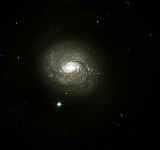
Messier 77
Encyclopedia
Messier 77 is a barred spiral galaxy
about 47 million light-year
s away in the constellation
Cetus
. Messier 77 is an active galaxy with an Active Galactic Nucleus
(AGN), which is obscured from view by astronomical dust at visible wavelengths. The diameter of the molecular disk and hot plasma associated with the obscuring material was first measured at radio wavelengths by the VLBA
and VLA
. The hot dust around the nucleus was subsequently measured in the mid-infrared by the MIDI instrument at the VLT
I. It is the brightest Seyfert galaxy
and is of type 2.
Messier 77's diameter is 170,000 light-years.
in 1780, who originally described it as a nebula. Méchain then communicated his discovery to Charles Messier
, who subsequently listed the object in his catalog. Both Messier and William Herschel
described this galaxy as a star cluster. Today, however, the object is known to be a galaxy.
Spiral galaxy
A spiral galaxy is a certain kind of galaxy originally described by Edwin Hubble in his 1936 work The Realm of the Nebulae and, as such, forms part of the Hubble sequence. Spiral galaxies consist of a flat, rotating disk containing stars, gas and dust, and a central concentration of stars known as...
about 47 million light-year
Light-year
A light-year, also light year or lightyear is a unit of length, equal to just under 10 trillion kilometres...
s away in the constellation
Constellation
In modern astronomy, a constellation is an internationally defined area of the celestial sphere. These areas are grouped around asterisms, patterns formed by prominent stars within apparent proximity to one another on Earth's night sky....
Cetus
Cetus
Cetus is a constellation. Its name refers to Cetus, a sea monster in Greek mythology, although it is often called 'the whale' today. Cetus is located in the region of the sky that contains other water-related constellations such as Aquarius, Pisces, and Eridanus.-Ecliptic:Although Cetus is not...
. Messier 77 is an active galaxy with an Active Galactic Nucleus
Active galactic nucleus
An active galactic nucleus is a compact region at the centre of a galaxy that has a much higher than normal luminosity over at least some portion, and possibly all, of the electromagnetic spectrum. Such excess emission has been observed in the radio, infrared, optical, ultra-violet, X-ray and...
(AGN), which is obscured from view by astronomical dust at visible wavelengths. The diameter of the molecular disk and hot plasma associated with the obscuring material was first measured at radio wavelengths by the VLBA
Very Long Baseline Array
The Very Long Baseline Array is a system of ten radio telescopes controlled remotely from the Array Operations Center in Socorro, New Mexico by the National Radio Astronomy Observatory. The array works together as the world's largest dedicated, full-time astronomical instrument using the...
and VLA
Very Large Array
The Very Large Array is a radio astronomy observatory located on the Plains of San Agustin, between the towns of Magdalena and Datil, some fifty miles west of Socorro, New Mexico, USA...
. The hot dust around the nucleus was subsequently measured in the mid-infrared by the MIDI instrument at the VLT
VLT
VLT may stand for:* Very Large Telescope, a system of four large optical telescopes organized in an array formation, located in northern Chile...
I. It is the brightest Seyfert galaxy
Seyfert galaxy
Seyfert galaxies are a class of galaxies with nuclei that produce spectral line emission from highly ionized gas, named after Carl Keenan Seyfert, the astronomer who first identified the class in 1943...
and is of type 2.
Messier 77's diameter is 170,000 light-years.
History
Messier 77 was discovered by Pierre MéchainPierre Méchain
Pierre François André Méchain was a French astronomer and surveyor who, with Charles Messier, was a major contributor to the early study of deep sky objects and comets.-Life:...
in 1780, who originally described it as a nebula. Méchain then communicated his discovery to Charles Messier
Charles Messier
Charles Messier was a French astronomer most notable for publishing an astronomical catalogue consisting of deep sky objects such as nebulae and star clusters that came to be known as the 110 "Messier objects"...
, who subsequently listed the object in his catalog. Both Messier and William Herschel
William Herschel
Sir Frederick William Herschel, KH, FRS, German: Friedrich Wilhelm Herschel was a German-born British astronomer, technical expert, and composer. Born in Hanover, Wilhelm first followed his father into the Military Band of Hanover, but emigrated to Britain at age 19...
described this galaxy as a star cluster. Today, however, the object is known to be a galaxy.

